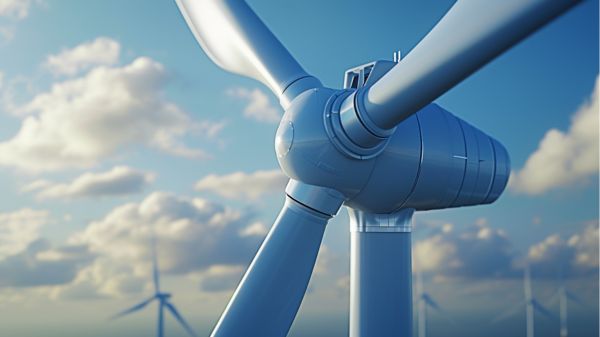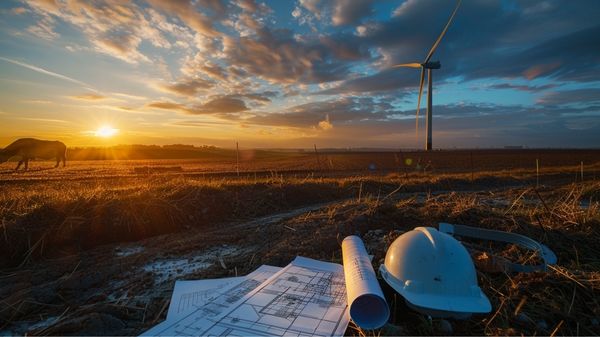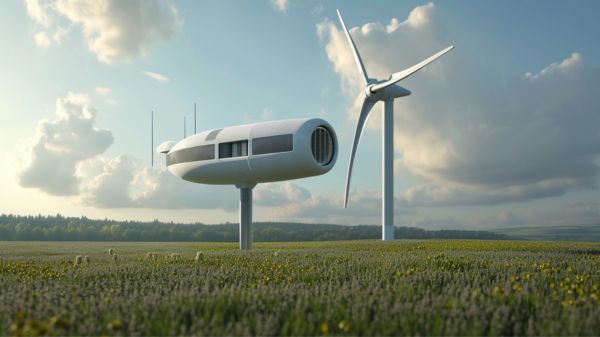Offshore wind turbine technology presents a compelling case for the future of renewable energy, offering advantages that extend well beyond mere electricity generation. These turbines harness an inexhaustible resource, contributing greatly to the reduction of carbon emissions and improving overall air quality. Additionally, the minimal environmental impact and job creation opportunities associated with offshore wind energy are remarkable. The recent advancements in cost-efficiency and innovative turbine designs also promise a more reliable energy supply and substantial economic growth. Understanding these key advantages is essential to appreciate the full potential of offshore wind energy.
⚡OFF-GRID POWER⚡
Build a Home Power Backup—No Utility Needed
Looking to keep essentials running during outages? The Ultimate Off-Grid Generator course walks you through a DIY backup system with simple parts and step-by-step plans — ideal for homesteads, cabins, or emergency prep.
Key Takeaways
- Offshore wind turbines provide a renewable and sustainable energy source with minimal environmental impact.
- They significantly reduce carbon emissions, combating climate change and improving air quality.
- Offshore wind energy creates numerous job opportunities, supporting local economies and skilled labor demand.
- Technological advancements have made offshore wind energy cost-efficient, with decreasing operational costs.
- Positioned near population centers, offshore wind turbines enhance grid stability and reduce energy transmission losses.
Renewable Energy Source
Offshore wind turbines represent a renewable energy source that remains inexhaustible and makes a significant contribution to sustainable power generation. These structures harness wind energy over the ocean, where wind speeds are generally higher and more consistent than on land. This consistency ensures a reliable and continuous supply of energy, which is essential for meeting the ever-growing demand for electricity.
The renewable nature of offshore wind energy eliminates the dependency on finite resources such as fossil fuels, contributing to energy security and economic stability. According to the Global Wind Energy Council, the potential for offshore wind energy is immense, with estimates suggesting that it could meet global electricity demand multiple times over. This underscores the transformative potential of offshore wind turbines in the renewable energy landscape.
Additionally, the deployment of offshore wind farms can be strategically planned to maximize efficiency and minimize environmental impacts. Their placement in coastal areas not only takes advantage of stronger winds but also positions them near population centers, reducing the energy loss associated with long-distance transmission.
This geographical advantage enables a more efficient energy distribution network, further strengthening the case for offshore wind turbines as a cornerstone of future energy strategies.
Reduced Carbon Emissions
Offshore wind turbines markedly reduce carbon emissions by substituting fossil fuel-based energy sources with clean, renewable power. This shift not only lowers greenhouse gas emissions but also contributes to improved air quality by reducing pollutants associated with fossil fuel combustion.
Consequently, offshore wind energy is instrumental in mitigating climate change and promoting a sustainable energy future.
Lower Greenhouse Gas Emissions
Harnessing wind energy from offshore turbines provides a substantial reduction in greenhouse gas emissions, thereby serving as a critical strategy in the fight against climate change. Offshore wind energy is a clean energy source that generates electricity without burning fossil fuels, leading to a significant decrease in carbon dioxide (CO2) emissions.
This reduction is vital as CO2 is a primary greenhouse gas contributing to global warming. Data indicates that offshore wind farms can displace a substantial amount of CO2 annually, positioning them as a key element in mitigating climate change.
The analytical assessment of offshore wind power underscores its effectiveness in cutting down greenhouse gases. For instance, one gigawatt (GW) of offshore wind capacity can save approximately 1.5 million metric tons of CO2 each year. This clean energy shift not only addresses climate change but also aligns with global sustainability goals.
Besides, offshore wind turbines eliminate the emission of other harmful pollutants such as nitrogen oxides (NOx) and sulfur dioxide (SO2), further enhancing their environmental benefits.
Improved Air Quality
The significant reduction in greenhouse gas emissions from offshore wind turbines directly correlates with improved air quality by decreasing the reliance on fossil fuels that pollute the atmosphere. Offshore wind power generates clean energy, effectively reducing harmful greenhouse gases such as carbon dioxide, which are primary contributors to global climate change.
By shifting energy production away from fossil fuels, offshore wind power mitigates the release of pollutants like nitrogen oxides (NOx), sulfur dioxide (SO2), and particulate matter (PM2.5), all of which have adverse effects on air quality and public health.
Empirical data consistently show that regions adopting offshore wind energy experience a marked decrease in air contaminants. For instance, studies have demonstrated that offshore wind installations can reduce greenhouse gas emissions by approximately 1.3 metric tons per megawatt-hour compared to coal-fired power plants. This substantial reduction translates into cleaner air, resulting in fewer respiratory and cardiovascular issues among the populace.
Moreover, the elimination of harmful greenhouse pollutants aligns with international climate goals, fostering a more sustainable environment.
Minimal Environmental Impact
Offshore wind turbines present a minimal environmental impact, noticeably lower than traditional energy sources, by eliminating the emission of air pollutants and greenhouse gases. Their low visual footprint and harmonious integration with marine ecosystems further underscore their environmental advantages.
Additionally, the meticulous installation processes are designed to minimize seabed disturbances, ensuring minimal disruption to marine life.
Reduced Carbon Emissions
By providing clean, renewable energy, offshore wind turbines greatly lessen carbon emissions, presenting a sustainable alternative to fossil fuel-based energy sources. These turbines are pivotal in reducing greenhouse gas emissions, which are the primary drivers of global climate change.
According to various studies, offshore wind farms can markedly lower the carbon footprint of energy production by displacing the need for carbon-intensive power generation methods, such as coal and natural gas.
Data from the Global Wind Energy Council indicates that a single offshore wind turbine can offset approximately 4,000 metric tons of CO2 annually, equivalent to removing over 1,000 cars from the road each year. This significant reduction in carbon emissions highlights the critical role offshore wind energy plays in global decarbonization efforts.
Moreover, the scalability of offshore wind farms allows for large-scale deployment, further amplifying their positive environmental impact. The International Renewable Energy Agency (IRENA) projects that offshore wind could meet up to 10% of global electricity demand by 2050, notably contributing to the reduction of greenhouse gas emissions.
As the world shifts toward a more sustainable energy future, the adoption of offshore wind turbines represents a transformative step in achieving low-carbon energy goals and combating climate change.
Low Visual Footprint
Strategically positioned far from the shore, offshore wind turbines offer a low visual footprint, thereby minimizing their environmental impact on coastal areas. This strategic placement ensures that these turbines are largely out of sight, blending seamlessly into the horizon and preserving the natural aesthetic of coastal landscapes.
Data from numerous studies highlight that the visual impact of offshore wind turbines is markedly less intrusive compared to onshore counterparts. By being located far offshore, these structures maintain the scenic views that are essential for coastal communities and tourism-driven economies.
Analytical reviews of coastal regions with offshore wind installations demonstrate a negligible effect on property values and tourism. This is a significant finding given the economic importance of maintaining an unspoiled visual environment. For instance, a report from the National Renewable Energy Laboratory (NREL) indicates that the majority of beachgoers and residents do not perceive offshore wind turbines from the shore, thereby preserving the natural beauty and tranquility of these regions.
The minimalist visual presence of offshore wind turbines represents a harmonious integration of renewable energy solutions with environmental preservation. This balance is fundamental for fostering public acceptance and supporting the broader goal of sustainable development and energy independence.
Job Creation Opportunities
The burgeoning offshore wind industry promises to generate substantial employment opportunities, with projections indicating the support of over 83,000 jobs in the U.S. by 2030. This job creation is pivotal for economic growth, particularly in sectors such as manufacturing, installation, and maintenance.
Each gigawatt (GW) of offshore wind capacity installed can create approximately 4,000 direct and indirect jobs, spanning roles in engineering, project management, and logistical support. A detailed breakdown of job creation in the offshore wind industry can be seen in the table below:
| Sector | Job Types |
|---|---|
| Manufacturing | Technicians, Engineers, Fabricators |
| Installation | Installers, Supervisors, Operators |
| Maintenance | Technicians, Inspectors, Managers |
| Engineering | Design Engineers, Project Managers |
| Logistical Support | Coordinators, Analysts, Drivers |
The offshore wind industry’s capacity to stimulate local employment is instrumental in revitalizing coastal economies. The direct engagement of local labor in these projects fosters community development and reduces unemployment rates. Additionally, the industry’s growth translates into increased demand for ancillary services, further amplifying its economic impact.
Cost-Efficiency
Lowering the costs of offshore wind turbines by 32% over the past decade has made this renewable energy source increasingly competitive with traditional power generation methods. This significant reduction in expenses stems from technological advancements and economies of scale, which have driven down both construction and operational costs.
As a result, offshore wind energy has emerged as a cost-efficient alternative to fossil fuels and other conventional energy sources. The financial viability of offshore wind projects is further supported by long-term contracts and stable revenue streams. These factors guarantee predictable returns on investment, thereby attracting more capital into the sector.
Moreover, the operational costs of offshore wind turbines continue to decline over time, enhancing their overall affordability. This shift towards cost-efficiency is not only a financial advantage but also a step towards energy liberation. By reducing dependency on volatile fossil fuel markets, offshore wind turbines contribute to a more stable and secure energy landscape.
The declining costs make it feasible for more regions to adopt this sustainable power generation method, promoting a cleaner, greener future. Hence, the cost-efficiency of offshore wind energy is a cornerstone in the progress towards a more sustainable and economically viable energy paradigm.
Higher Energy Output
Building on the cost-efficiency gains, offshore wind turbines also offer noticeably higher energy output compared to their onshore counterparts. The key to this substantial increase lies in the engineering advancements that allow for larger blades and taller turbine structures.
These innovations enable offshore wind turbines to capture more wind energy, translating to a significantly higher generation capacity. With the abundant offshore wind resources, these turbines can harness stronger and more consistent wind patterns, contributing to a more reliable and sustainable energy source.
Empirical data indicates that offshore wind turbines can generate up to twice as much electricity as onshore installations. This higher energy output is critical for feeding the power grid with a steady supply of renewable energy, thereby reducing reliance on fossil fuels and fostering a cleaner environment. Additionally, the capacity for larger turbines offshore allows for more efficient energy production, maximizing the potential of each installation.
The implications of this enhanced energy output are profound. As nations work towards energy independence and environmental sustainability, offshore wind energy emerges as a pivotal component of the modern power grid. This shift not only transforms the energy landscape but also empowers communities by providing a robust, renewable energy source.
Proximity to Population Centers
Strategically positioning offshore wind turbines near population centers leverages the proximity to high-demand coastal and Great Lakes states, where nearly 80% of U.S. electricity demand is concentrated.
This geographic advantage notably reduces energy loss during transmission, as shorter connection lines are required to deliver power from offshore turbines to urban load centers. Coastal cities, in particular, are poised to benefit from this setup, receiving reliable and sustainable energy solutions directly from nearby offshore wind farms.
The proximity of these turbines to population centers ensures that electricity generation is closely aligned with consumption patterns, effectively complementing peak demand times. By integrating seamlessly into the electrical grid, offshore wind energy meets the dynamic energy needs of homes and businesses, thereby enhancing overall grid stability and efficiency. The strategic placement of these turbines facilitates a reduction in dependency on long-distance transmission networks, which can be prone to inefficiencies and energy losses.
Furthermore, this localized energy production model empowers coastal cities to adopt greener practices and reduce their carbon footprint, fostering a sustainable future. The close connection between offshore wind resources and high-demand areas underscores the potential of this renewable energy source to revolutionize the energy landscape, promoting liberation from fossil fuel dependency.
Innovation in Turbine Design
Amidst the advantageous closeness of offshore wind turbines to population centers, innovative turbine designs further enhance the effectiveness of harnessing abundant offshore wind resources.
Today’s offshore wind turbines are engineered to reach impressive heights, standing 1.5 times taller than the Washington Monument. This significant elevation allows turbines to capture stronger and more consistent wind currents, thereby optimizing energy production.
A critical element of this innovation in turbine design is the blade length, which can extend as long as a football field. The increased blade length is directly correlated with higher energy output, as larger blades can sweep a greater area and capture more wind energy.
This design not only amplifies the efficiency of power generation but also maximizes the potential of offshore wind energy resources, making it a pivotal component in the shift to renewable energy.
Furthermore, the integration of advanced materials and aerodynamic improvements in turbine design contributes to reduced wear and tear, enhancing the longevity and reliability of these colossal structures.
As a result, the innovation in turbine design not only bolsters energy output but also secures sustainable and efficient power generation, aligning with the broader goals of energy independence and environmental stewardship.
Energy Supply Reliability
Offshore wind turbines offer a reliable energy supply, capitalizing on the consistent wind patterns prevalent over oceanic expanses. These steady wind resources translate into a continuous and predictable power generation capability, greatly enhancing the reliability of the energy sector.
Unlike terrestrial wind farms, which are subject to variable land-based wind conditions, offshore installations benefit from more stable and robust wind flows, ensuring higher energy efficiency and a more consistent output.
By integrating offshore wind power into the electrical grid, energy supply reliability is significantly improving. This stability is vital for reducing reliance on fossil fuels, which are prone to price volatility and supply disruptions. Furthermore, offshore wind farms can generate substantial electricity even during peak demand periods, thereby supporting grid stability and reducing the risk of outages.
The consistent and sustainable power generation from offshore wind turbines aligns with the broader objective of shifting to a cleaner and more resilient energy system. This change not only supports environmental objectives but also strengthens the overall reliability of energy supply, contributing to a more liberated and energy-efficient future.
Consequently, offshore wind turbines play a pivotal role in fortifying the energy sector against uncertainties and fostering a robust and sustainable energy infrastructure.
Economic Growth Potential
Offshore wind turbines present a significant economic growth opportunity, with projections indicating billions of dollars in investments for coastal states and the creation of over 10,000 well-paying jobs in New York alone.
Economic impact studies emphasize the sector’s potential for substantial job creation and investment opportunities, further buoyed by the expansion of the maritime industry.
These factors collectively underscore the robust economic benefits driving the adoption of offshore wind development in the U.S.
Job Creation Surge
The implementation of offshore wind turbines is projected to create over 10,000 jobs in New York State, driving substantial economic growth and workforce development. This job creation surge is fueled by the extensive scope of offshore wind projects, which include construction, maintenance, and operations roles.
Various studies affirm the massive potential for job creation, highlighting the direct and indirect employment opportunities within the maritime industry and associated sectors.
| Sector | Job Type |
|---|---|
| Construction | Engineers, Technicians |
| Operations | Maintenance Workers |
| Maritime | Vessel Operators |
New York State’s commitment to expanding offshore wind initiatives has catalyzed this employment boom. This sector not only promises jobs but also nurtures a skilled workforce tailored to the renewable energy domain. The evolving landscape of offshore wind projects invites a spectrum of professions, from engineers to vessel operators, ensuring diverse and inclusive employment.
Moreover, the burgeoning demand for sustainable energy solutions amplifies the significance of this industry. It underscores a transformative shift towards economic liberation, where sustainable practices and economic growth coalesce. The job creation surge from offshore wind projects in New York State serves as a demonstration of the profound economic and societal benefits of renewable energy initiatives.
Investment Opportunities Abound
As New York State capitalizes on the employment surge from offshore wind initiatives, significant investment opportunities emerge, with billions of dollars anticipated to flow into the renewable energy sector. The economic growth potential in this domain is not just theoretical but supported by concrete data and projections.
Offshore wind farms represent a burgeoning market segment that can attract substantial capital inflows, driving economic expansion across multiple sectors. To understand the economic implications, consider the following:
- Job Creation: Offshore wind projects are expected to generate over 10,000 jobs in New York State alone, stimulating local economies and fostering community development.
- Capital Inflows: Investment in offshore wind farms is projected to reach billions, spurring financial activities and boosting related industries such as manufacturing and logistics.
- Regional Economic Growth: Studies indicate that regions engaged in offshore wind development experience significant economic uplift, benefiting from enhanced infrastructure and increased business activities.
These investment opportunities are not merely financial transactions but a pathway to economic liberation. They empower regions to shift towards sustainable energy, fostering resilience and self-sufficiency.
In this light, offshore wind farms are a catalyst for broad-based economic growth, offering a transformative impact on communities and investors alike.
Maritime Industry Boost
Harnessing the power of offshore wind turbines greatly boosts the maritime industry, driving economic growth and modernization through substantial job creation and investment.
Offshore wind development channels billions of dollars into coastal economies, acting as a significant catalyst for regional economic expansion. For instance, in New York State alone, the burgeoning offshore wind sector is poised to generate more than 10,000 well-paying jobs, underscoring its transformative potential.
Various studies illuminate the profound economic advantages intrinsic to offshore wind turbines. The maritime industry, traditionally reliant on shipping and fishing, is now witnessing diversification and modernization.
The influx of capital facilitates the construction of new ports, maintenance facilities, and specialized vessels tailor-made for wind farm installation and upkeep. This infrastructural evolution creates a ripple effect, enhancing local supply chains and fostering ancillary industries.
The job creation trajectory is not merely quantitative but qualitative; these roles span from skilled technical positions to high-level engineering and project management. Consequently, the offshore wind sector is forging a new economic landscape, characterized by sustainable development and long-term growth.
Conclusion
Offshore wind turbines offer a strong solution to energy demands by leveraging renewable sources to reduce carbon emissions and improve air quality. Through minimal environmental disruption and job creation, they offer significant economic benefits.
Technological advancements enhance cost-efficiency and guarantee reliable energy supply. Proximity to population centers facilitates energy distribution, while innovative turbine designs drive further efficiencies. Offshore wind farms consequently represent a crucial investment in sustainable energy and economic growth potential.
⚡OFF-GRID POWER⚡
Build a Home Power Backup—No Utility Needed
Looking to keep essentials running during outages? The Ultimate Off-Grid Generator course walks you through a DIY backup system with simple parts and step-by-step plans — ideal for homesteads, cabins, or emergency prep.




